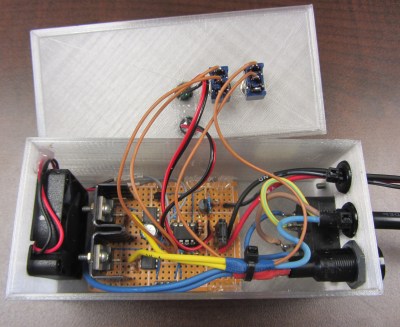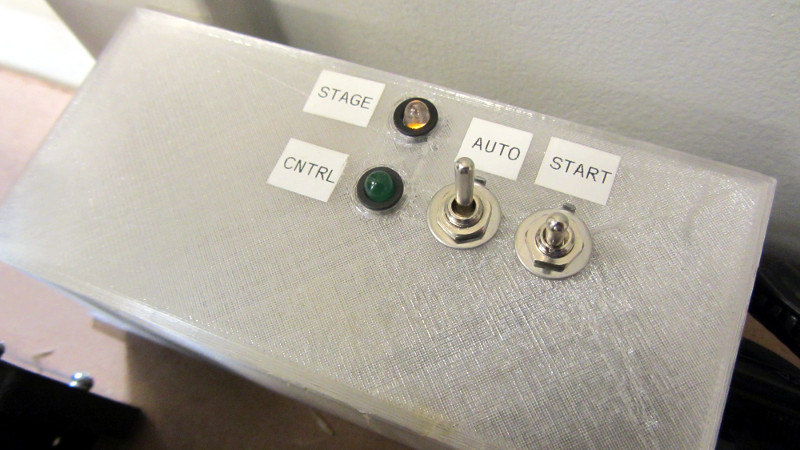At this point you’ve probably already heard the news: cheap Chinese 3D printers sometimes catch fire. Now we can’t say we’re shocked to find out that absolute bottom of the barrel gear wasn’t designed to the highest standards (gotta cut those corners someplace), but that doesn’t change the fact that there are thousands of hackers and makers out there who are in possession of one of these suspect machines. Just tossing them to the curb is hardly the hacker way, so we’ve got to find ways to make the best of the hand dealt to us.
 After sleeping with one eye (and maybe one nostril) open during some overnight prints, Hackaday.io user [TheGrim] wanted a way to make sure his Alunar Anet A6 didn’t stay powered on any longer than necessary. So he came up with a way of using the printer’s own endstop switch to detect if the print has completed, and cut the power.
After sleeping with one eye (and maybe one nostril) open during some overnight prints, Hackaday.io user [TheGrim] wanted a way to make sure his Alunar Anet A6 didn’t stay powered on any longer than necessary. So he came up with a way of using the printer’s own endstop switch to detect if the print has completed, and cut the power.
The idea is simple, but of course the real trick is in the implementation. By adding a “Home” command to his ending G-Code in Cura, [TheGrim] reasoned he could use the Y endstop switch to determine if the print had completed. It was just a matter of reading the state of the switch and acting on it.
In the most basic implementation, the switch could be used to control a relay on the AC side of the power supply. But [TheGrim] doesn’t trust relays, and he wanted to pack in a couple “smart” features so he ended up using a PIC microcontroller and two 12 amp TRIACs. There’s also a couple of LEDs and toggle switches to serve as the user interface, allowing you to enable and disable the automatic shutdown and get status information about the system.
Will cutting the juice to the PSU prevent another terrible fire? It’s debatable. But it certainly can’t hurt, and if it makes [TheGrim] feel more confident about running his machine, then so be it. We’d still advise anyone with a 3D printer at home to brush up on their fire safety knowledge.
















but then he needs to build another one to shut the first one down and so on
I think this is a better solution, it adds an alert if for breaks out.
https://www.grainger.com/product/KIDDE-3-x-1-3-4-x-3-4-Relay-Module-3KN55
But what if it catches fire mid-print ?
I would say, since you have a ‘safety’ system let it monitor ambient temp. of the printer and maybe a cheapass smoke detector rigged to silent alarm the controller to shut-off the printer and maybe alert the owner ?
Altho this setup is safer then non it doesnt really take all scenarios into account.
Why would you rig the smoke detector to be silent? Shut off the printer AND wake me up!
Yeah, merely shutting off the printer when there is already open flame is pretty insufficient. Would be cool to have an automatic fire extinguisher operated by a solenoid. Just make sure it’s not made in England or it’ll catch fire too.
Okay… I could not resist positing this clip in response to your comment (the fire extinguisher catches fire at around 1:00):
https://www.youtube.com/watch?v=1EBfxjSFAxQ
FIRE! FIRE! HELP!
I’ve taken care of it!
The printer would almost certainly catch fire mid-print. The most common culprit on those Anets is thermal runaway, when the temperature probe slips out of its socket and the dumb controller just thinks the hot end is never finished heating up so it never cuts the current. Not having thermal runaway protection is a real fuck-up. Best way to fix it is to get a RAMPS board and put Marlin on it. Also fix all those hot bed connections that eventually get wiggly and arc.
If the print has successfully finished, the controller has cut current to the heating elements and the danger is basically nil. I thought this project was going to be one of those printer pause-resume boxes which would make a lot more sense for safety.
The Anet printers can have Marlin flashed on them, as mine does and from the MANY forums on the ANET line 90% of issues are the hotbed connector catching fire 5% runaway and 5% PSU giving the magic smoke. The hotbed connector is a POS it was the 1st part I replaced soldering it directly to the hotbed and placing a proper connection about 1/2 way between the board and the hotbed so if the bed dies I can replace it – yet the connector is in a place that doesnt get any movement to cause issues with the connection.
Doesn’t trust relays?!
Sometimes you just can’t trust relays:
https://hackaday.com/2018/05/11/fake-omron-relays-are-worth-what-you-pay-for-them/
I’ve heard of enough APC UPS systems with welded contacts… This’ll be very bad in a faulty/failing 3D Printer! (:-o)-<-{
Heck, even the toggle switch on my desktop’s PSU welds from time to time.
I’m assuming “relays” in this context means electromagnetic and not solid state. But, yeah I kinda don’t trust those either.
And yet DOES trust Triacs, hand-wired on perfboard. What could go wrong?
I have done that with sonoff modules on my machines:
https://www.youtube.com/watch?v=0tB7b_evsGw
It’s probably worth mentioning that the Marlin firmware has an option (not compiled in by default) for controlling a power supply. Marlin will send a signal when it needs the power supply on for motors, heaters, etc. It’s meant for controlling an ATX power supply, so technically Marlin grounds the output to turn on the power supply, but it works well with a relay and a transistor to invert the signal.
“(gotta cut those corners someplace)”
Bahh!
I can understand that there will be problems with something built to the bottom price. There could be components removed that were only there for safety. There can be shoddy workmanship if it’s built by the cheapest labor on the tightest time and with the least quality review.
But…
They used Marlin, a FREE (both as in beer and speech) firmware. They turned off safety features that were on by default and free to leave on.
I can’t understand that!
Well, depends on which base version they used if all protections where on. On older versions only the MIN/MAX temp errors where on by default.
And, I’ve had users demand to turn off certain safety features as they where going off during print, ruining prints. Naturally, the cause was a real problem in the printer. But the user experiences a problem that only happens once every X prints and thus blames software. So that might explain why those features are off, they where triggering, quickest fix is to turn them off. Not understanding the consequences.
(FIY, I’ve been working at Ultimaker for 6 years now, I’ve seen my share of sillyness)
Get a steel table in the shed to put your printer on, keep flammables away from it and relax
Yeah I had it catch fire in midprint. The Heating block did not hold the heating element in place, slipped out resting on the print, ramping up the rig to try to get the temp of the heat block up. So over all had to air out my house and spend $100 on parts to fix it
Well, my little cheapie tarantula cuts power to nozzle and the heated bed when done. About a 1 percent probability of a fire happening at this time, after print is done. 99 percent probability of fire while heating bed or nozzle… Worthless hack
A bit of an oversight to not have any vent holes in the enclosure for the fan…
It won’t be doing much cooling of those heat sinks, possibly leading to overheating and maybe worse.
Looks like he only ended up moving the failure point into a little plastic box, or just addad another failure point.
Out of the frying pan, into the fire…..
Also, a relay wouldn’t NEED a heatsink and/or fan.
Don’t the chap printers generally fail when high current is flowing through cheap parts. This doesn’t really solve any problem related to a printer catching fire?
After the print so little current flows therefore the probability of it catching fire is low compared to when it was actually printing.
Indeed, I see no way this really helps in fire protection. The linked article mentions “wear on the switch mode power supply”, specifically on capacitors. But capacitors don’t show wear, they show age. Bad ones dry out with age.
Powersupplies, thanks to all kinds of certification processes, are tested to hell. They are the least likely component to fail catastrophically.
So, yes, of all fire protection you want on your printer, this is the last one on the list.
Has anyone done a proper DIY fire suppression system for 3d printers/laser cutters/CNC routers etc?
Surely cutting power and dumping a CO2 extinguisher into a sealed(ish) enclosure would be fun.
https://en.m.wikipedia.org/wiki/Thermal_cutoff
A thermal fuse seems like it might also be a good idea.
A real good idea, and more effective, and less complicated.
I think good solution for enclosed 3d printers might be something like this. http://www.dds-czech.cz/protengelectro.php ( translate to english , couldn’t find eng version of the page ).
It is just hose with sealed extinguishing agent, which is released when temperature reaches 120C.
The only issue I see is the activation temperature of 120 C. Not sure if it will not cause “false alarms”.
I liked that design as it is simply stupid.
Am I really the only one bothered by the use of paper PCB stuck to the case with hot glue? A device that’s supposed to prevent fire made of flammable materials?
You’re not, but it’s at the low end of a long list of what’s wrong with this hack. See all comments above.
So, he has mains voltage running about in a non-earthed plastic box.
With metal parts (switch casings), which protrude to the outside of the box.
If live AC gets to that, the switch toggle will become live, and there’s no earth connection to it to blow the fuse.
This should be in a metal box. (which is earthed).
While the intentions here may be valid, does this solution REALLY reduce the chance of your house burning down? Why not try some simple solutions that may work. First yes fix the firmware if you can. Next, add some thermal fuses which cost maybe $2 each. Then find a smoke alarm with a relay or add a relay which are readily available and have that relay turn off printer power and notify the user. Finally mount a device like Stovetop Firestop above the printer to actually put out a fire. These cost about $20 each. These solutions are cheaper and might actually do something.